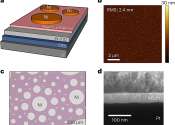AI program writes music and lyrics
The Rolling Stones summed up popular music in a simple phrase and title in their Eighties hit "It's Only Rock 'n Roll."
Computer Sciences

The Rolling Stones summed up popular music in a simple phrase and title in their Eighties hit "It's Only Rock 'n Roll."
Robotics

The notion of a large metallic robot that speaks in monotone and moves in lumbering, deliberate steps is somewhat hard to shake. But practitioners in the field of soft robotics have an entirely different image in mind—autonomous ...
Apr 15, 2022
0
266
Engineering

Two teams of solar-power engineers, one led by a large group at Helmholtz-Zentrum Berlin für Materialien und Energie GmbH, the other led by a group at École Polytechnique Fédérale de Lausanne, has found two ways to improve ...
Business

Silicon Valley is poised once again to cash in on other people's products, making a data grab of unprecedented scale that has already spawned lawsuits and congressional hearings.
Jun 23, 2023
0
13
Electronics & Semiconductors

Quantum computers are promising computing machines that perform computations leveraging the collective properties of quantum physics states. These computers could help to tackle many computational problems that are currently ...
Energy & Green Tech

The cost of solar power is beginning to reach price parity with cheaper fossil fuel-based electricity in many parts of the world, yet the clean energy source still accounts for just slightly more than 1 percent of the world's ...
Aug 29, 2016
0
2517
Energy & Green Tech

While conventional silicon-based solar cells have had an unmistakable impact on the buildout of renewable energy resources around the world, additional performance improvements have become increasingly difficult to make as ...
Sep 5, 2023
0
55
Hardware

Everyone is talking about the newest AI and the power of neural networks, forgetting that software is limited by the hardware on which it runs. But it is hardware, says USC Professor of Electrical and Computer Engineering ...
Mar 29, 2023
0
416
Hardware

A smartphone shutting down on a sweltering day is an all-too-common annoyance that may accompany a trip to the beach on a sunny afternoon. Electronic memory within these devices isn't built to handle extreme heat.
Apr 30, 2024
0
72
Energy & Green Tech

Costs of solar panels have plummeted over the last several years, leading to rates of solar installations far greater than most analysts had expected. But with most of the potential areas for cost savings already pushed to ...
Jan 27, 2020
2
175
Silicon (pronounced /ˈsɪlɨkən/ or /ˈsɪlɨkɒn/, Latin: silicium) is the most common metalloid. It is a chemical element, which has the symbol Si and atomic number 14. The atomic mass is 28.0855. A tetravalent metalloid, silicon is less reactive than its chemical analog carbon. As the eighth most common element in the universe by mass, silicon very rarely occurs as the pure free element in nature, but is more widely distributed in dusts, planetoids and planets as various forms of silicon dioxide (silica) or silicates. On Earth, silicon is the second most abundant element (after oxygen) in the crust, making up 25.7% of the crust by mass.
Silicon has many industrial uses. It is the principal component of most semiconductor devices, most importantly integrated circuits or microchips. Silicon is widely used in semiconductors because it remains a semiconductor at higher temperatures than the semiconductor germanium and because its native oxide is easily grown in a furnace and forms a better semiconductor/dielectric interface than any other material.
In the form of silica and silicates, silicon forms useful glasses, cements, and ceramics. It is also a constituent of silicones, a class-name for various synthetic plastic substances made of silicon, oxygen, carbon and hydrogen, often confused with silicon itself.
Silicon is an essential element in biology, although only tiny traces of it appear to be required by animals. It is much more important to the metabolism of plants, particularly many grasses, and silicic acid (a type of silica) forms the basis of the striking array of protective shells of the microscopic diatoms.
This text uses material from Wikipedia, licensed under CC BY-SA